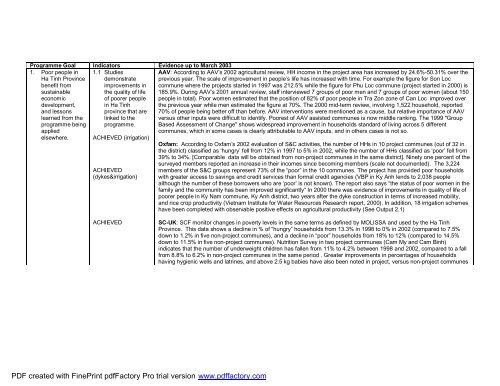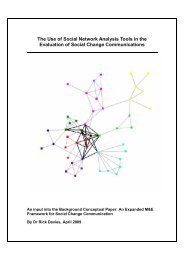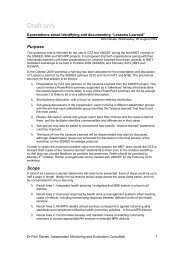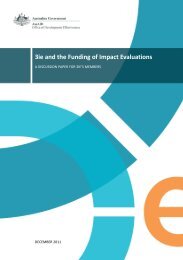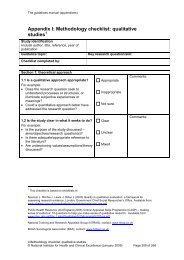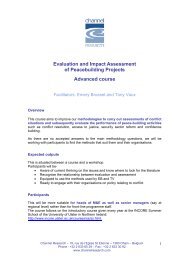DFID 2003 Ha Tinh PCR.pdf - Monitoring and Evaluation NEWS
DFID 2003 Ha Tinh PCR.pdf - Monitoring and Evaluation NEWS
DFID 2003 Ha Tinh PCR.pdf - Monitoring and Evaluation NEWS
You also want an ePaper? Increase the reach of your titles
YUMPU automatically turns print PDFs into web optimized ePapers that Google loves.
Programme Goal Indicators Evidence up to March <strong>2003</strong><br />
1. Poor people in<br />
<strong>Ha</strong> <strong>Tinh</strong> Province<br />
benefit from<br />
sustainable<br />
economic<br />
development,<br />
<strong>and</strong> lessons<br />
learned from the<br />
programme being<br />
applied<br />
elsewhere.<br />
1.1 Studies<br />
demonstrate<br />
improvements in<br />
the quality of life<br />
of poorer people<br />
in <strong>Ha</strong> <strong>Tinh</strong><br />
province that are<br />
linked to the<br />
programme.<br />
ACHIEVED (irrigation)<br />
ACHIEVED<br />
(dykes&irrigation)<br />
AAV: According to AAV’s 2002 agricultural review, HH income in the project area has increased by 24.6%-50.31% over the<br />
previous year. The scale of improvement in people’s life has increased with time. For example the figure for Son Loc<br />
commune where the projects started in 1997 was 212.5% while the figure for Phu Loc commune (project started in 2000) is<br />
185.9%. During AAV’s 2001 annual review, staff interviewed 7 groups of poor men <strong>and</strong> 7 groups of poor women (about 150<br />
people in total). Poor women estimated that the position of 82% of poor people in Tra Zon zone of Can Loc improved over<br />
the previous year while men estimated the figure at 70%. The 2000 mid-term review, involving 1,522 household, reported<br />
70% of people being better off than before. AAV interventions were mentioned as a cause, but relative importance of AAV<br />
versus other inputs were difficult to identify. Poorest of AAV assisted communes is now middle ranking. The 1999 "Group<br />
Based Assessment of Change" shows widespread improvement in households st<strong>and</strong>ard of living across 5 different<br />
communes, which in some cases is clearly attributable to AAV inputs, <strong>and</strong> in others cases is not so.<br />
Oxfam: According to Oxfam’s 2002 evaluation of S&C activities, the number of HHs in 10 project communes (out of 32 in<br />
the district) classified as ‘hungry’ fell from 12% in 1997 to 5% in 2002, while the number of HHs classified as ‘poor’ fell from<br />
39% to 34%. [Comparable data will be obtained from non-project communes in the same district]. Ninety one percent of the<br />
surveyed members reported an increase in their incomes since becoming members (scale not documented). The 3,224<br />
members of the S&C groups represent 73% of the “poor” in the 10 communes. The project has provided poor households<br />
with greater access to savings <strong>and</strong> credit services than formal credit agencies (VBP in Ky Anh lends to 2,038 people<br />
although the number of these borrowers who are ‘poor’ is not known). The report also says “the status of poor women in the<br />
family <strong>and</strong> the community has been improved significantly“ In 2000 there was evidence of improvements in quality of life of<br />
poorer people in Ky Nam commune, Ky Anh district, two years after the dyke construction in terms of increased mobility,<br />
<strong>and</strong> rice crop productivity (Vietnam Institute for Water Resources Research report, 2000). In addition, 18 irrigation schemes<br />
have been completed with observable positive effects on agricultural productivity (See Output 2.1)<br />
ACHIEVED<br />
SC-UK: SCF monitor changes in poverty levels in the same terms as defined by MOLISSA <strong>and</strong> used by the <strong>Ha</strong> <strong>Tinh</strong><br />
Province. This data shows a decline in % of “hungry” households from 13.3% in 1998 to 0% in 2002 (compared to 7.5%<br />
down to 1.2% in five non-project communes), <strong>and</strong> a decline in “poor” households from 18% to 12% (compared to 14.5%<br />
down to 11.5% in five non-project communes). Nutrition Survey in two project communes (Cam My <strong>and</strong> Cam Binh)<br />
indicates that the number of underweight children has fallen from 11% to 4.2% between 1998 <strong>and</strong> 2002, compared to a fall<br />
from 8.8% to 6.2% in non-project communes in the same period . Greater improvements in percentages of households<br />
having hygienic wells <strong>and</strong> latrines, <strong>and</strong> above 2.5 kg babies have also been noted in project, versus non-project communes<br />
PDF created with FinePrint <strong>pdf</strong>Factory Pro trial version www.<strong>pdf</strong>factory.com


